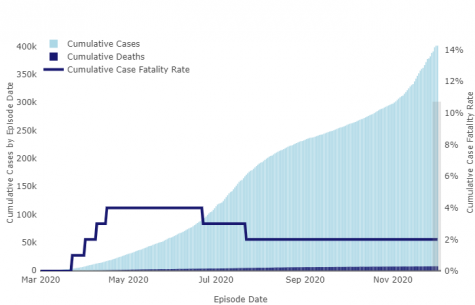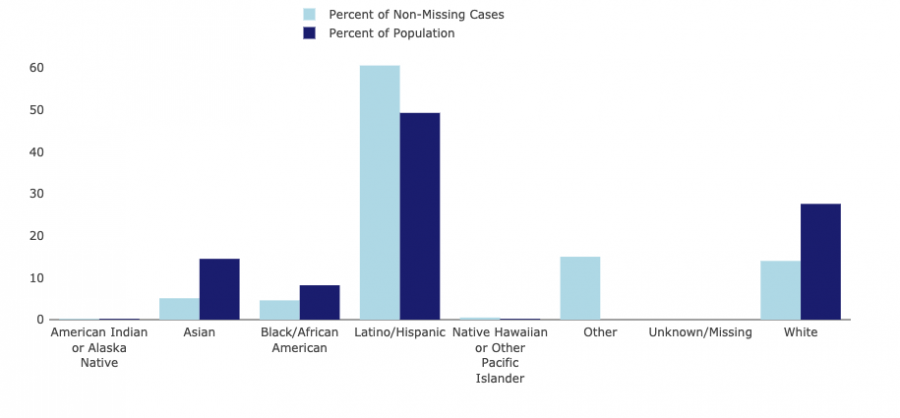COVID-19 Update: Newsom announces temporary stay-at-home order for regions where ICU capacity falls below 15%
December 4, 2020
Los Angeles County has the highest number of cumulative cases in the United States, while multiple other counties in California see a rise in the number of cases per capita.
The Centers for Disease Control and Prevention forecasts an upward trend in the number of deaths nationwide. L.A. County currently holds the record for the most confirmed cases in the nation.
We have compiled data and guidance from the Los Angeles County Department of Public Health to provide an update for L.A. County. Data is up to date as of Dec. 4. Here is your weekly COVID-19 update.
Local official updates:
Gov. Gavin Newsom announces temporary stay-at-home order for regions whose ICU capacity falls below 15%
Newsom announced a temporary stay-at-home order on Thursday that will go into effect in regions that fall below 15% ICU capacity.
The five regions are categorized as Northern California, Greater Sacramento, Bay Area, San Joaquin Valley and Southern California. If a region falls below the 15% threshold, a stay-at-home order will remain in place for three weeks.
Southern California could fall below 15% ICU capacity in the coming weeks, according to Newsom.
As soon as a region falls under capacity, bars, wineries, personal services, hair salons and barbershops would temporarily close for three weeks.
However, schools, critical infrastructure, retail and restaurants would remain open during the order. Retail capacity would be limited to 20% and restaurants would only be open for takeout and delivery.
During this time, Newsom encouraged residents to do outdoor activities to take care of their mental and physical health.
“We encourage those activities, this is really important to take care of your physical health, to take care of your mental health, to get the kind of exercise that is required to get us through this temporary moment,” Newsom said. “This is not a permanent state, this is what many had projected, we had predicted, the final surge in this pandemic.”
California’s vaccine distribution plan has been drafted
Newsom announced on Monday that California is set to receive 327,000 doses of the Pfizer COVID-19 vaccine. Newsom explained who would be the first to receive the vaccine during a press conference on Thursday.
A Drafting Guidelines Workgroup and the Community Advisory Vaccine Committee, both associated with the California Department of Public Health, has prioritized which groups will be the first to receive the vaccine. There are three tiers that will be among the first to be eligible for the vaccine.
The first tier includes workers at skilled nursing facilities, assisted living facilities, psychiatric and correctional facility hospitals, paramedics and other emergency medical services workers, and dialysis center employees.
The second tier includes community health workers, public health field staff, primary care clinics and immediate care facilities.
The third tier includes employees at laboratories, dental offices and pharmacy staff, who will also be prioritized in getting the vaccine.
“There is light at the end of the tunnel, we are a few months away from truly seeing real progress with the vaccine, real distribution, real accessibility, real availability,” Newsom said in a press conference on Wednesday.
L.A. Mayor Garcetti issues targeted safer at home order
On Wednesday, Garcetti issued a targeted safer-at-home order in which all residents must stay in their homes, unless they are doing essential activities, like buying groceries or working in essential businesses.
Most businesses and services remain operational, including medical facilities, religious services and grocery and retail stores. The order is intended to prevent gatherings between members of multiple households.
Except for traveling to essential services and locations, travel by foot, car, bicycle or public transit is prohibited.
Violation of the order is classified as a misdemeanor, subject to fines and imprisonment. Garcetti urged the Los Angeles Police Department and City Attorney’s office to enforce the new rules.
The Department of Water and Power also has the authority to cut off utilities to businesses and residents that are not compliant to the order.
“My message couldn’t be simpler, it’s time to hunker down,” Garcetti said in a press conference on Wednesday. “It’s time to cancel everything and if it isn’t essential, don’t do it.”
Garcetti announces financial relief for food service workers
Garcetti announced the Secure Emergency Relief for Vulnerable Employees, also known as SERVE, during a press conference on Wednesday. The initiative will provide up to 4,000 food service workers with a one-time $800 stipend.
The initiative is being funded by the Mayor’s Fund for Los Angeles.
Eligibility requirements and information to apply can be found here.
Travel guidelines change for L.A. city
Garcetti announced a new form that must be completed by any traveler arriving in L.A. from another state or country, acknowledging that they are aware of the required 14-day quarantine upon arrival.
The form must be completed by every traveler over the age of 16. Failure to submit the form could result in a $500 fine.
The form can be found here.
Total cases:

Since the first confirmed case of COVID-19 in L.A. County on Jan. 26, the number of positive cases continues to rise. Over 3% of L.A. County’s population of 10 million has had COVID-19.

CSUN cases:
As of Dec. 1, there have been 41 reported cases among students and 30 reported cases among employees.
There are two reported cases among non-employee contractors.
There are no current cases that have been reported as a result of on-campus exposure.

These cases are reported to CSUN by individuals or public health officials. The university does not disclose the specific location of infected individuals for privacy reasons, but potentially exposed areas are disinfected prior to reopening.
If you test positive for COVID-19, whether or not you have been on campus, notify Yolanda Chassiakos, the CSUN Pandemic Manager, by emailing linda.reid.chassiakos@csun.edu.
Hospitalizations:
There are 2,769 COVID-19 positive patients currently hospitalized in L.A. County. There are 640 COVID-19 positive patients in the Intensive Care Unit. The County currently has 486 available ICU beds.
Race and ethnicity:
L.A. County’s data shows cases and deaths disproportionately affect people of color.
The L.A. County Department of Public Health reported that Latinos make up 60.6% of cases with data on race and ethnicity compared to the population, while whites account for 14% of cases compared to the population.
Latinos account for 52% of all COVID-19 deaths when compared to the population.
What’s open:
Grocery stores – limited to 35% capacity
Essential retail – limited to 35% capacity
Some non-essential retail – limited to 20% capacity
Parks and beaches with modifications
Golf courses
Hotels with modifications
Shared residential pools
Gyms (outdoors with modifications)
Indoor shopping malls – limited to 20% capacity
Zoos (outdoors with modifications)
Restaurants and retail food facilities – pick-up or drive-thru only
Wineries/breweries – indoor retail only with a limit of 20% capacity
What’s closed:
Cardrooms
Indoor houses of worship
Indoor gyms
Bars
Tattoo shops
Nail salons
Hair salons
Barber shops
Face masks are still required in public. Gatherings should be limited to only people in your household.
Testing:
The L.A. County website has a list of testing locations available for both walk-up and drive-up testing. Testing is available by appointment only.
A comprehensive map of testing locations can be found here. Hours of operation at city testing locations have been extended from 8 a.m. to 4 p.m. daily.
